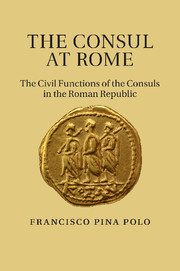Book contents
- Frontmatter
- Contents
- List of illustrations
- Acknowledgements
- Introduction
- PART I THE CONSULAR FUNCTIONS IN THE PRE-SULLAN AGE (367–81)
- 1 The consuls taking office
- 2 Consuls and civic religion
- 3 Consuls, the agents of diplomacy in the Roman state
- 4 Communication between the consuls and the people: edicts and contiones
- 5 Consuls as legislators
- 6 The jurisdiction of the consuls
- 7 Consuls as promoters of public works
- 8 Colonization and distribution of land
- 9 Appointment of a dictator
- 10 Consuls presiding over elections
- 11 The consular year in the pre-Sullan age
- PART II THE CONSULAR FUNCTIONS IN THE POST-SULLAN AGE (80–50)
- 15 Conclusion
- Bibliography
- Index of Subjects
- Index of Ancient Sources
- Index of Ancient Personal Names
4 - Communication between the consuls and the people: edicts and contiones
Published online by Cambridge University Press: 25 October 2011
- Frontmatter
- Contents
- List of illustrations
- Acknowledgements
- Introduction
- PART I THE CONSULAR FUNCTIONS IN THE PRE-SULLAN AGE (367–81)
- 1 The consuls taking office
- 2 Consuls and civic religion
- 3 Consuls, the agents of diplomacy in the Roman state
- 4 Communication between the consuls and the people: edicts and contiones
- 5 Consuls as legislators
- 6 The jurisdiction of the consuls
- 7 Consuls as promoters of public works
- 8 Colonization and distribution of land
- 9 Appointment of a dictator
- 10 Consuls presiding over elections
- 11 The consular year in the pre-Sullan age
- PART II THE CONSULAR FUNCTIONS IN THE POST-SULLAN AGE (80–50)
- 15 Conclusion
- Bibliography
- Index of Subjects
- Index of Ancient Sources
- Index of Ancient Personal Names
Summary
As has been seen in previous chapters, when carrying out their duties the consuls acted chiefly as the transmission system for decisions previously taken by the senate, fulfilling the instructions of the senators. In their role as intermediaries between senatus and populus they were in charge of making senatorial resolutions known to the people when they were in Rome, according to the formula specifically mentioned by Livy: ‘senatus censuit et consules edixerunt’ (‘the senate resolved and the consuls published an edict’). In their absence, one of the praetors, usually the urban praetor, would fulfil this duty. Communication between the consuls and the people took two different forms: in writing through edicts and orally through their personal appearance in a contio.
CONSULAR EDICTS
In fact, the two forms of communication complemented each other. As the word edicere indicates, an edictum should first be proclaimed, that is, announced orally in public. This would take place in a contio, the official assembly at which the Roman people received all sorts of information, summoned and presided over by the magistrate who produced the edict. This action was called edicere pro contione or in contione, and was simultaneously accompanied by the display of the edict in the most frequented public place possible, usually the forum, both means being used in order to inform the maximum number of people.
- Type
- Chapter
- Information
- The Consul at RomeThe Civil Functions of the Consuls in the Roman Republic, pp. 83 - 98Publisher: Cambridge University PressPrint publication year: 2011



